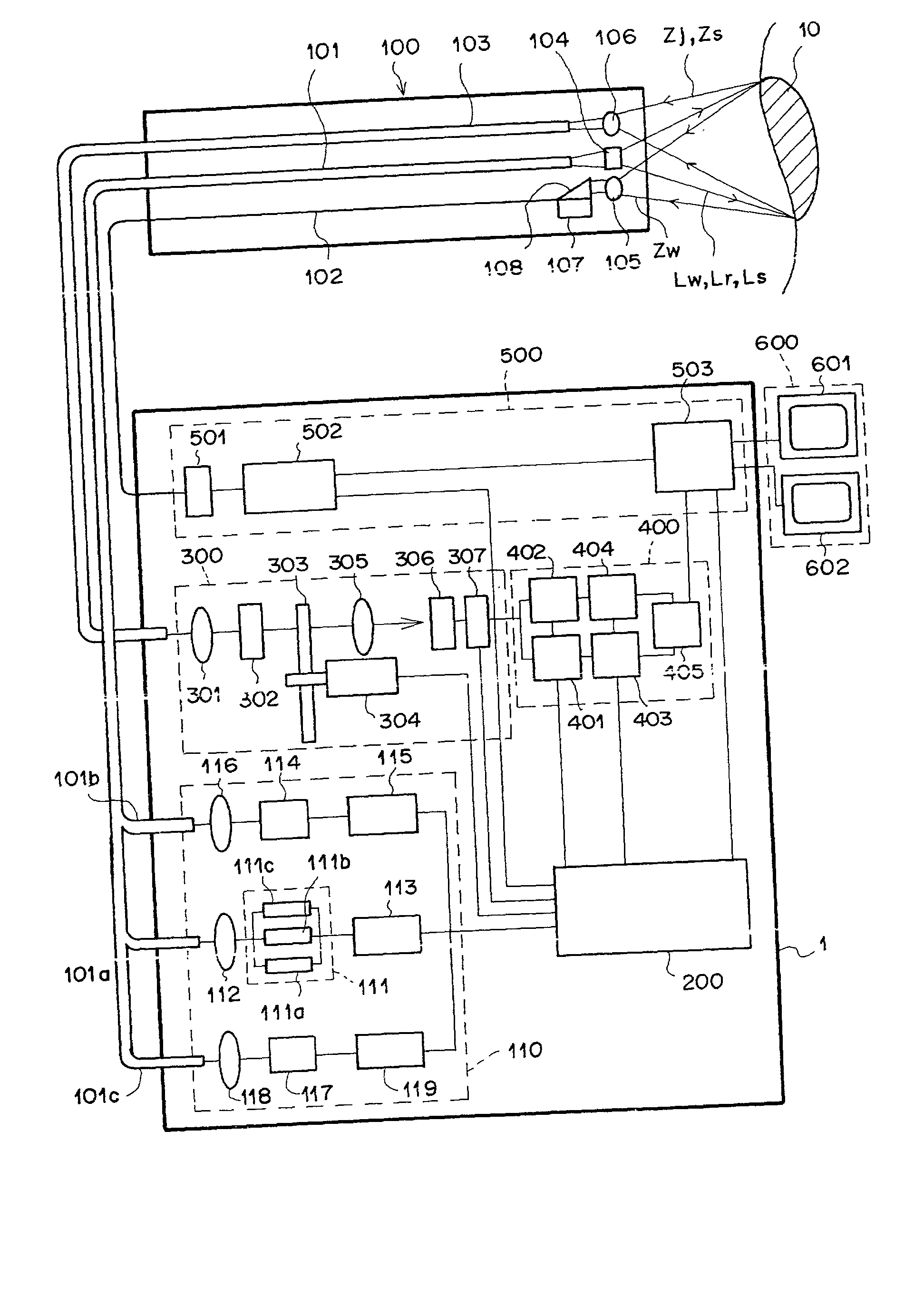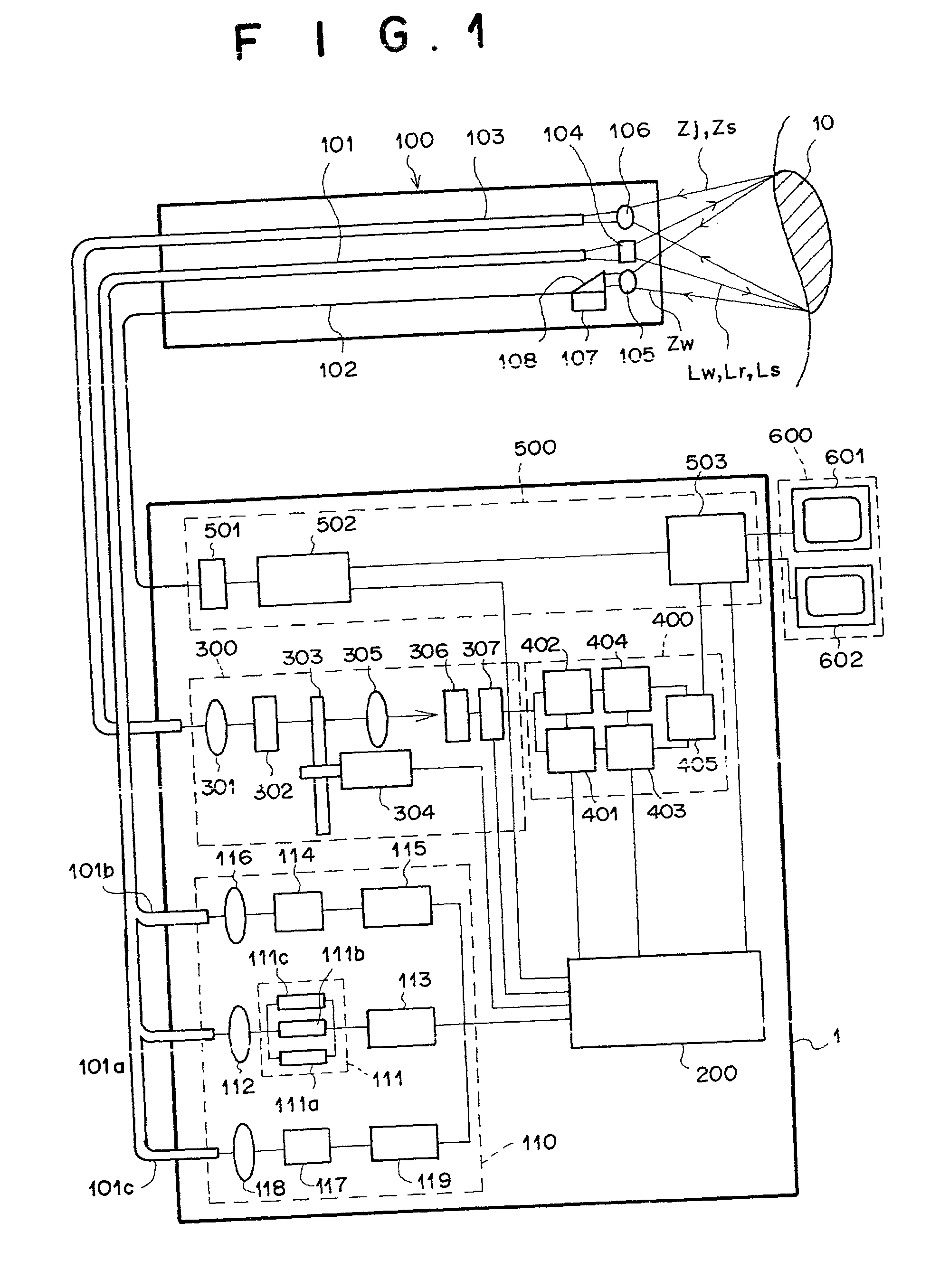Endoscope system having multiaxial-mode laser-light source or substantially producing multiaxial-mode laser light from single-axial-mode laser light
a laser light source and endoscope technology, applied in the field of endoscope systems, can solve the problems of inability to accurately discriminate the properties of living tissue, uniaxial intensity of excitation light applied to living tissue, and production of interference patterns
- Summary
- Abstract
- Description
- Claims
- Application Information
AI Technical Summary
Benefits of technology
Problems solved by technology
Method used
Image
Examples
first embodiment
[0056] Construction of First Embodiment
[0057] The first embodiment of the present invention is explained below. FIG. 1 is a diagram illustrating an outline of a construction of the fluorescence endoscope system as the first embodiment of the present invention. The fluorescence endoscope system of FIG. 1 realizes the functions of both the first and fifth aspects of the present invention. The fluorescence endoscope system of FIG. 1 comprises an image-information processing unit 1, an endoscope insertion unit 100, and a monitor unit 600. The endoscope insertion unit 100 is inserted into a portion of interest in a body of a patient. The image information processing unit 1 processes image information obtained from living tissue 10, and outputs processed image information. The monitor unit 600 displays a visible image based on the image information processed by the image information processing unit 1.
[0058] Specifically, the image information processing unit 1 comprises an illumination un...
second embodiment
[0087] Second Embodiment
[0088] The second embodiment of the present invention is explained below. FIG. 4 is a diagram illustrating an outline of a construction of the fluorescence endoscope system as the second embodiment of the present invention. In FIG. 4, elements having the same reference numbers as FIG. 1 have the same functions as the corresponding elements in FIG. 1, and explanations of the functions of the common elements are not repeated below. The fluorescence endoscope system of FIG. 4 realizes the functions of both the second and sixth aspects of the present invention. The fluorescence endoscope system of FIG. 4 is different from the fluorescence endoscope system of FIG. 1 in the light sources of the white light Lw and the excitation light Lr. That is, the fluorescence endoscope system of FIG. 4 comprises an illumination unit 120 instead of the illumination unit 110.
[0089] The illumination unit 120 comprises a white-light source 128 instead of the white-light source 111,...
third embodiment
[0094] Third Embodiment
[0095] The third embodiment of the present invention is explained below. FIG. 6 is a diagram illustrating an outline of a construction of the fluorescence endoscope system as the third embodiment of the present invention. In FIG. 6, elements having the same reference numbers as FIG. 1 have the same functions as the corresponding elements in FIG. 1, and explanations of the functions of the common elements are not repeated below. The fluorescence endoscope system of FIG. 6 realizes the functions of both the third and seventh aspects of the present invention.
[0096] The fluorescence endoscope system of FIG. 6 is different from the fluorescence endoscope system of FIG. 1 in that a vibrator (or shaker) 135 is attached to the white-light guide 101a, a vibrator (or shaker) 132 is attached to the excitation-light guide 101b, and controllers 136 and 133 for the vibrators 135 and 132 are provided. In addition, the fluorescence endoscope system of FIG. 6 comprises a white...
PUM
 Login to View More
Login to View More Abstract
Description
Claims
Application Information
 Login to View More
Login to View More - R&D
- Intellectual Property
- Life Sciences
- Materials
- Tech Scout
- Unparalleled Data Quality
- Higher Quality Content
- 60% Fewer Hallucinations
Browse by: Latest US Patents, China's latest patents, Technical Efficacy Thesaurus, Application Domain, Technology Topic, Popular Technical Reports.
© 2025 PatSnap. All rights reserved.Legal|Privacy policy|Modern Slavery Act Transparency Statement|Sitemap|About US| Contact US: help@patsnap.com



